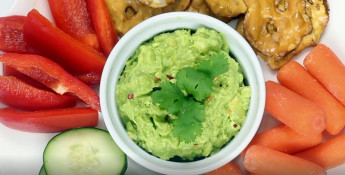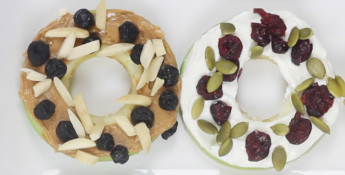By Cara Harbstreet on January 31, 2017
Healthy snack ideas

Let’s talk about snacks. They’re an important part of our day and no one wants to have a boring snack, am I right? I have four snack-tastic tips for you and your family plus some genius (yep, I said genius) ideas on how to pack the most punch and flavor into your snack-time routine.
Opportunity
Become an opportunistic eater at snack time if your goal is to truly balance total nutrition for the day. Snacks can become a chance to fill a nutrient gap and add foods that may otherwise be missing from our diet. When reaching for a snack late in the day, pause for a moment and do a quick review of what you’ve already eaten. Then you can ask, “Have I had any fruit today? What about a vegetable?” If the answer is no, including those foods in your snack can get you closer to the recommended amounts of fruits and vegetables for the day.
Variety
Many of us, and especially young children, can fall into a pattern where we only crave certain foods, flavors or textures. This is known as a food jag, and while it’s not necessarily a problem, it can leave nutrition gaps. It can take up to 15 or more exposures to accept a new food, so variety and consistency in snack food offerings is key.
Including two or more food groups is a good rule of thumb to follow. If we combine fruits, vegetables, grains, protein and fat into snacks, we end up with the ideal combination of nutrients to keep us full and satisfied. We need carbohydrates for energy, but the combo of protein + fat + fiber helps us sustain that energy and avoid feeling hungry again.
Timing
Snacks are designed to hold us over until our next meal, not replace a meal. A snack in the range of 150 to 250 calories for an adult (or less for a child) is usually all that’s needed to take the edge off our hunger. Depending on individual appetites and schedules, I recommend going no longer than three to four hours without eating. Snacks can help stabilize blood sugar levels and sustain energy throughout the day when we cycle them into our overall eating pattern. However, it’s very easy to go overboard with a snack and consume 400 or 500 calories (or more) if we aren’t mindful of our portion sizes. So be aware of your hunger, take your time and make adjustments as needed until you find the right balance that works for your lifestyle.
Cravings
We often become preoccupied with feeding a craving at snack time. This is usually more related to an emotional or stress-related trigger for eating, rather than physical hunger. Children sometimes crave foods that are familiar to them and might stick to a limited variety of foods. However, there are some healthful options for when certain cravings surface.
Need some snack ideas? Try these:






